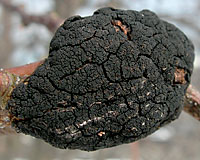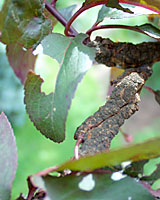Terry L. Ettinger Horticulture Consulting Services
Meeting The Needs Of Today With A Vision For The Future
Question of the Week
Black Knot of Plums, Prunes & Cherries
 Q. I have a Canadian Cherry tree that's 10-15 ft. tall and about 12-13 years old. Over the last three to four years it started
developing what looks like a lumpy black growth on its limbs that's getting worse every year. The last couple of years we pruned the branches that had this growth, but now it is all over
the tree! Is there any treatment available for controlling it?
Q. I have a Canadian Cherry tree that's 10-15 ft. tall and about 12-13 years old. Over the last three to four years it started
developing what looks like a lumpy black growth on its limbs that's getting worse every year. The last couple of years we pruned the branches that had this growth, but now it is all over
the tree! Is there any treatment available for controlling it?
A. You've provided a perfect description for a common disease of more than twenty different cherry, plum and prune trees called "Black Knot."
 The part of the fungus that infects new growth each spring are called ascospores. Millions of ascospores, which
are black, cover the surface of each growth, left. In the spring rainfall splashes the structures from the growths,
or "knots," onto
newly emerging stems.
The part of the fungus that infects new growth each spring are called ascospores. Millions of ascospores, which
are black, cover the surface of each growth, left. In the spring rainfall splashes the structures from the growths,
or "knots," onto
newly emerging stems.
 Infection of new, green shoots occurs from April through June during periods of warm, wet weather,
at right. The fungus grows
through the soft bark and spreads among cells within the shoot. It also releases a growth promoting chemical, causing the
shoot to begin to swell and often bend in unusual directions.
Infection of new, green shoots occurs from April through June during periods of warm, wet weather,
at right. The fungus grows
through the soft bark and spreads among cells within the shoot. It also releases a growth promoting chemical, causing the
shoot to begin to swell and often bend in unusual directions.
The characteristic black, knot-like growths actually become visible during late summer and autumn a year and a half after the initial infection. Because ascospores from one and one-half year-old knots infect new growth each spring, itís important to prune all visible knots out of infected trees when it's above freezing in January, February and March. Because infected tissue can exist a number of inches below visible knots, pruning cuts must be made at least eight inches below the black, visible portion of each infection.
Also keep in mind that infectious ascospores can be released from infected twigs and stems even after they've been removed. So, it's important to burn, bury or otherwise dispose of all prunings.
Where large numbers of wild cherry, plum or prune grow nearby, the application of fungicides has been recommended in the past to protect succulent new growth until the period of infection period ends in mid-to late June.
However, at this time (April of 2007), there are no fungicides labeled/recommended for use in New York for controlling black knot infections on bearing fruit trees, or in landscape plantings.
Therefore, where infection sources (wild cherries, plums and prunes) are common the only practical option may be to remove heavily infected trees and avoid replanting with susceptible species.